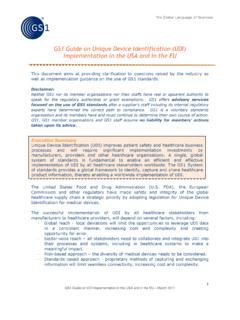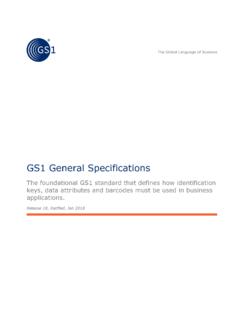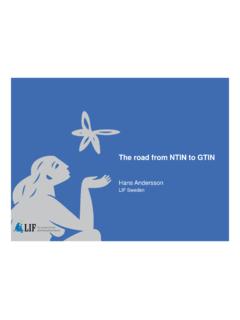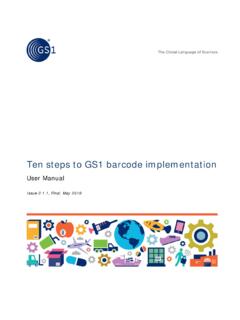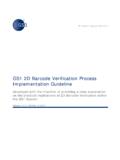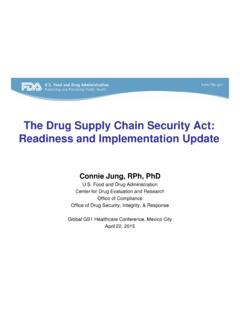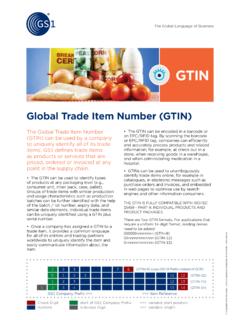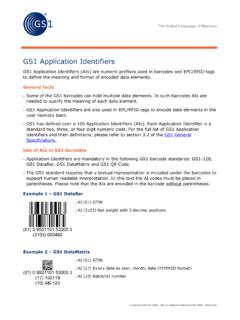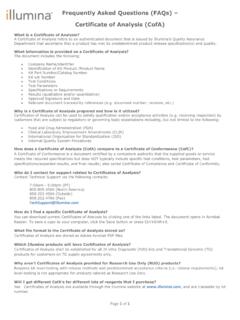Transcription of Guideline for Unique identification of products with SGTIN ...
1 Guideline for Unique identification of products with SGTIN (serialized GTIN). Labelling with GS1 Datamatrix barcode and tagging with EPC / RFID Gen 2 UHF RFID tags Release - 27. June 2018 Page 2 Document information Document Document name Guideline SGTIN and RFID Document date 1 June 2018 Document version Contributors to the document Name Organisation Geir Vevle ACT Logimark AS Birger Hodt Draka Norsk Kabel Anders Bru Glamox Egil Wist GS1 Norway Geir Paulsen GS1 Norway Knut Mathisen GS1 Norway Knut Vala GS1 Norway Roar Lorvik GS1 Norway Terje Menkerud GS1 Norway ivind Pettersen Skanska Frode Mohus Statsbygg Inge Aarseth Sykehuset i Vestfold.
2 T nsberg project Bengt Herning Virke Log of changes Release Date of changes Changed by Summary of change Page 3 Table of Contents 1. Background .. 4 2. Purpose and application for Unique ID and labelling / tagging of products .. 4 3. Allocation of SGTIN (Serialized GTIN) .. 4 Subscription of GS1 Company Prefix (GCP) .. 4 Allocation of GTIN and serialization .. 4 Use of GS1 AIs for Application identification .. 5 Structure of GTIN and SGTIN in a barcode and EPC / RFID Gen 2V2 RFID tag .. 6 4. Labelling of GS1 Datamatrix 2D 8 GS1 Datamatrix 2D barcode.
3 8 Size of the barcode .. 8 Quality of the barcode and desired length of life .. 9 Placement of the barcode on the product .. 9 Readability of the barcode .. 9 5. Tagging with EPC / RFID Gen 2 UHF RFID chip .. 9 Structure / content in the RFID chip .. 9 Enhanced User Memory .. 12 Alternative types of RFID tags .. 12 The length of life of the RFID chip .. 13 Placement and fastening / mounting of the RFID tag .. 13 Security / Encryption of content in the RFID tag .. 13 6. Data capture .. 14 Data capture using Datamatrix barcode readers .. 14 Datamatrix reading equipment.
4 14 Reading distance .. 14 Data capture using RFID readers .. 14 RFID readers and equipment .. 14 RFID Software Solutions .. 14 7. Testing RFID solutions .. 15 Readability of RFID tagged objects .. 15 Reading distance from RFID antennas to RFID tagged 15 8. Check list for manufacturers and suppliers.. 16 9. Information about GS1 .. 16 10. References and glossary: .. 17 Page 4 1. Background Several of the actors in the Building, Construction and Facility Management sector has given GS1 Norway the task of developing a Guideline for Unique identification and labelling / tagging of products , including the use of GS1 Datamatrix barcodes and RFID.
5 The principals are Sykehuset i Vestfold / T nsberg project and Statsbygg. GS1's open international standards shall be used for the tasks covered in this Guideline . This Guideline contains the primary activities and instructions for assigning and proper use of SGTIN (Serialized GTIN). In addition, it is explained how labelling with GS1 Datamatrix barcode and tagging with GS1's standard for EPC / RFID Gen2 UHF RFID chips should be conducted by a manufacturer / supplier for its products . More information about EPC / RFID Gen2 is in the Reference list in chapter 10. products exist in numerous variants regarding shape, size and performance.
6 Thus, this Guideline provides only general instructions. This Guideline provides advice and tips that are useful to take into consideration when identifying and labelling / tagging products . 2. Purpose and application for Unique ID and labelling / tagging of products Unique identification and labelling / tagging of products is a very important and prioritized area for the Building, Construction and Facility Management sector. The purpose of Unique identification and labelling / tagging is to ensure that product and information flow in value chains become easier, faster and safer, thus contributing to effective construction site logistics as well as Management, Repair and Operations (MRO).
7 This will result in reduced costs for all actors in the value chain. Unique identification and labelling / tagging shall be used by manufacturers and suppliers of building and construction products , and must be used throughout the value chain for efficient logistics and traceability of products and deliveries. Suppliers must therefore take actions and apply solutions that enable them to label their products according to GS1's standards for identification , labelling / tagging and traceability . 3. Allocation of SGTIN (Serialized GTIN) Subscription of GS1 Company Prefix (GCP) The allocation of SGTIN requires a subscription of GS1 Company Prefix (GS1 GCP).
8 This allows for Unique identification of products . When applying for a GS1 Company Prefix (GCP) from GS1 Norway, unless otherwise specified, you will receive a GS1 GCP with a capacity based on the information given in the application form. This does only apply to the number of different products , not identical products of the same kind. Different units of the same identical product are identified with serial numbers. This may be different at other GS1 offices in other countries. For more information about application of GS1 GCP from GS1 Norway, see the Reference list in chapter 10.
9 Allocation of GTIN and serialization A product, for which it is required to know predefined information, has to be uniquely identified to make this possible. For this purpose, GTIN (Global Trade Item Number) is used. Page 5 identification and labelling / tagging of products enable automation of processes such as production, inventory management, shipping and goods reception. This is also used for internal logistics at construction site, for assembly and in Management, Repair and Operation (MRO) throughout the life time of the building. It is the individual manufacturer or brand owner who is responsible for subscribing to a GS1 Company Prefix and assign GTIN to their products .
10 GS1 has guidelines that help avoid duplicates and reuse of GTINs. Each product that is different from another in design and / or content is assigned a Unique GTIN. This remains the same as long as the product exists. The same GTIN is assigned to all identical products . The Serialized Global Trade Item Number ( SGTIN ) is an add-on to GTIN that allows you to individually identify different units of the same product. A GTIN itself does not provide Unique identification of each unit of a product because it does not uniquely identify each instance of a physical object. GTIN identifies a specific group of identical products (single SKU), while SGTIN identifies each unit of identical products using serial numbers.
